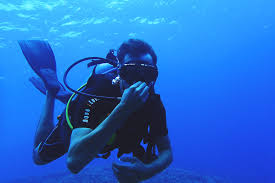Overview
Quick Navigation
More than 70 percent of the earth’s surface is made up of water, and yet most people only know the world as it is on dry land. A small percentage of the world’s population has had the privilege of getting to know the underwater world. These are referred to as Divers.
Read about the Carolina rig here.
A question that many aspiring divers ask themselves is, “do I really need to know how to swim to scuba dive?”. While you might think the answer is ready-made, it doesn’t have to be. Before we see why let’s catch a glimpse of the origin of diving
Origin of diving
Five thousand years before our era began, people felt the need to explore the world underwater. Diving started almost simultaneously with this need. Because people did not yet have the knowledge and materials as we do today, these dives in history naturally looked very different than today.
The reasons people over the centuries gave for diving have varied from military purposes and rescue work to recreation and hunting. Even nowadays, you see these motives coming back, although the relationship has changed. The biggest motivation for people to dive nowadays is relaxation and interest.
You can also read about the difference between wetsuits and drysuits.
Knowing How To Swim – Meaning
What does “know how to swim” mean? It is knowing how to move on the surface of the water without panicking or losing these means. In short, it is overcoming your fear of water and learning how to demonstrate control. Then there are as many ways to swim as there are people on earth.
Of course, there are excellent swimmers and very good divers. But in any case, know that if you are a beginner in swimming, or that you do not think you have the right level, you will improve! Remember, even the best swimmers learned and weren’t born like this. Have confidence in yourself. Read about the differences between dive fins and snorkel fins here.
Do you need to know how to swim for scuba diving?
Knowing how to swim is not mandatory for Scuba Diving, especially if it’s your first time diving. The first-time diving is effectively supervised by professionals in the discipline.
Also, you will be equipped efficiently with vest, wetsuit, bottle, mask, and fin. All of these would make you feel comfortable and confident in the water. Furthermore, diving will be much fun with additional diving tips from Instructors.
As long as you are accompanied by a trusted person, you can even go down a little underwater to make the most of the moment. Otherwise, you can stay on the surface and just look underwater with your mask on. If you want to fully enjoy the pleasures of scuba diving and move effectively underwater, it will be preferable to be already sufficiently comfortable on the sea surface and know how to dive and stay a little underwater without equipment.
Again, the trick is to check with the nearest swimming school and do regular pool training. With or without fins, although training with a fin will be a big plus if you want to dive afterward. Read about the different fishing rod types and uses here.
Swimming and Scuba diving
For the continuation and the rise in diving level. You will often be asked to pass swimming tests, such as successfully swimming without stopping a set distance.
The goal is to obtain a level 1 certificate. This certificate allows you to dive without the assistance of another person. Remember that scuba diving is a risky activity: marine currents, animal species, waves, etc. Knowing how to swim is therefore imperative to be able to protect yourself from all problematic situations underwater. For example, for an expedition, it is advisable to go in an organized group and not alone.
This level 1 in diving also allows access to the practice of the underwater scooter even if no obligation is required, it is common sense. If you are not comfortable and you go quickly underwater, you might as well say that you increase the risk of an accident.
Therefore, to be a certified scuba driver, your ability to swim will be tested. However, you don’t necessarily have to be an expert in swimming. In Diving certification programs like PADI Open Water Course, aspiring divers would be tested via a 200m swim without the use of swimming aids or 300m swim with the help of swimming aids; ten minutes floating in the water, without the assistance of a floatation device.
For aspiring divers who are physically challenged, there are adaptive techniques used in most training programs to meet the requirements of the training standard.
The ability to swim and float, as a requirement for diving certification is to determine how much comfortable an aspiring diver will be in the water; determine if an aspiring diver will be able to float to the water surface after handing their apparatus over, for a time; determine if he will be able to swim back to the boat or shore, in an unlikely situation of Diving apparatus malfunction.
Read about the different types of diving weights here.
Anyone can dive
Diving is a sport where people discover below the water surface and can be practiced by anyone interested in it. So anyone can dive, whether you are young or old, experienced or inexperienced. If you have no diving experience, it is useful to do a diving course, but this is not mandatory if there is an instructor to guide you.
What you need to know when you go diving
In addition to its many attractions, the underwater world also has several limitations for humans. For example, there is no oxygen, the water impedes certain human senses, and the pressure of the water affects the body. These are all consequences of natural laws that must be taken into account. So anyone can dive, provided you have access to the right materials and the fitting instructions. You can also read about the different types of finning techniques
What you need for diving
To be able to make a dive and to overcome the limitations described above, proper diving equipment is necessary. Scuba gear includes a suit to protect you and to prevent heat loss, a scuba tank and regulator for oxygenation, weights to allow you to descend, a BCD to adjust your buoyancy, a mask to view, and fins to facilitate swimming.
Conclusion
Diving is one of the fastest-growing adventure sports in the world. Developments over the years have ensured that diving is easy, safe, and accessible to everyone. What is still holding you back? Not knowing how to swim should not hold you back. Get started now!

